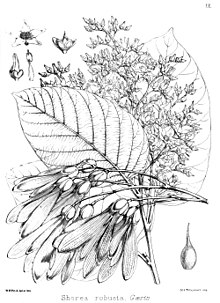Sal tree
| Sal | |
|---|---|
 |
|
| Scientific classification | |
| Kingdom: | Plantae |
| (unranked): | Angiosperms |
| (unranked): | Eudicots |
| (unranked): | Rosids |
| Order: | Malvales |
| Family: | Dipterocarpaceae |
| Genus: | Shorea |
| Species: | S. robusta |
| Binomial name | |
|
Shorea robusta Roth |
|
| Synonyms | |
|
Vatica robusta |
|
Vatica robusta
Shorea robusta, also known as śāl, sakhua or shala tree, is a species of tree belonging to the Dipterocarpaceae family.
This tree is native to the Indian subcontinent, ranging south of the Himalaya, from Myanmar in the east to Nepal, India and Bangladesh. In India, it extends from Assam, Bengal, Odisha and Jharkhand west to the Shivalik Hills in Haryana, east of the Yamuna. The range also extends through the Eastern Ghats and to the eastern Vindhya and Satpura ranges of central India. It is often the dominant tree in the forests where it occurs. In Nepal, it is found mostly in the Terai region from east to west, especially, in the Churia range (The Shivalik Hill Churia Range) in the subtropical climate zone. There are many protected areas, such as Chitwan National Park, Bardia National Park and Shukla Phat Wildlife Reserve, where there are dense forests of huge sal trees. It is also found in the lower belt of the Hilly region and inner terai.
Sal tree is also known as Sakhua in northern India including Madhya Pradesh, Odisha and Jharkhand.
Sal is moderate to slow growing, and can attain heights of 30 to 35 m and a trunk diameter of up to 2-2.5 m. The leaves are 10–25 cm long and 5–15 cm broad. In wetter areas, it is evergreen; in drier areas, it is dry-season deciduous, shedding most of the leaves in between February to April, leafing out again in April and May.
...
Wikipedia

